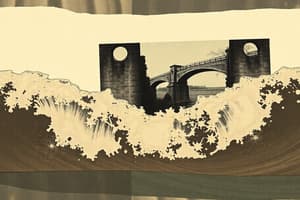Podcast
Questions and Answers
What type of wave has particles that oscillate in the same direction as the energy transfer?
What type of wave has particles that oscillate in the same direction as the energy transfer?
- Longitudinal Waves (correct)
- Electromagnetic Waves
- Transverse Waves
- Stationary Waves
Which term describes the height of the wave on a graph?
Which term describes the height of the wave on a graph?
- Amplitude (correct)
- Time Period
- Wavelength
- Frequency
What is the relationship expressed in the wave equation?
What is the relationship expressed in the wave equation?
- Wavelength = Frequency x Speed
- Speed = Frequency x Wavelength (correct)
- Frequency = Amplitude x Wavelength
- Amplitude = Speed x Frequency
Which of the following best describes a node in a stationary wave?
Which of the following best describes a node in a stationary wave?
How is polarization defined in the context of waves?
How is polarization defined in the context of waves?
What is the characteristic feature of the first harmonic in a stationary wave?
What is the characteristic feature of the first harmonic in a stationary wave?
In which of the following scenarios would polarization occur?
In which of the following scenarios would polarization occur?
What is the time it takes for one complete wave cycle to pass a point called?
What is the time it takes for one complete wave cycle to pass a point called?
What occurs during constructive interference of two waves?
What occurs during constructive interference of two waves?
In a single slit diffraction experiment, what determines the width of the diffraction fringes?
In a single slit diffraction experiment, what determines the width of the diffraction fringes?
What does the path difference formula for destructive interference indicate?
What does the path difference formula for destructive interference indicate?
How does total internal reflection work in optical fibers?
How does total internal reflection work in optical fibers?
What aspect of light does a diffraction grating help to measure?
What aspect of light does a diffraction grating help to measure?
What is the refractive index 'n' of a vacuum approximately equal to?
What is the refractive index 'n' of a vacuum approximately equal to?
Which phenomenon occurs when a wave changes direction at the boundary between two different media?
Which phenomenon occurs when a wave changes direction at the boundary between two different media?
What relationship does Snell's Law describe?
What relationship does Snell's Law describe?
What causes pulse broadening in optical fibers?
What causes pulse broadening in optical fibers?
What is the critical angle in the context of refraction?
What is the critical angle in the context of refraction?
What characterizes a graded index optical fiber?
What characterizes a graded index optical fiber?
What type of waves can cause stationary wave patterns in a Kundt's tube?
What type of waves can cause stationary wave patterns in a Kundt's tube?
In the context of diffraction grating, what does 'd' denote?
In the context of diffraction grating, what does 'd' denote?
What happens to light when it transitions from a denser medium to a less dense medium?
What happens to light when it transitions from a denser medium to a less dense medium?
Flashcards
Wave
Wave
A disturbance that transfers energy through a medium or a field, often characterized by oscillations or vibrations.
Progressive Waves
Progressive Waves
Waves that transfer energy without transferring matter. The particles in the medium oscillate as the wave passes through.
Longitudinal Waves
Longitudinal Waves
Waves in which the particles of the medium oscillate parallel to the direction of energy transfer.
Transverse Waves
Transverse Waves
Signup and view all the flashcards
Amplitude
Amplitude
Signup and view all the flashcards
Wavelength (λ)
Wavelength (λ)
Signup and view all the flashcards
Time Period (T)
Time Period (T)
Signup and view all the flashcards
Frequency (f)
Frequency (f)
Signup and view all the flashcards
Wave Interference
Wave Interference
Signup and view all the flashcards
Constructive Interference
Constructive Interference
Signup and view all the flashcards
Destructive Interference
Destructive Interference
Signup and view all the flashcards
Path Difference
Path Difference
Signup and view all the flashcards
Diffraction
Diffraction
Signup and view all the flashcards
Single Slit Diffraction
Single Slit Diffraction
Signup and view all the flashcards
Central Maximum
Central Maximum
Signup and view all the flashcards
Double Slit Diffraction
Double Slit Diffraction
Signup and view all the flashcards
Diffraction Grating
Diffraction Grating
Signup and view all the flashcards
Kundt's Tube
Kundt's Tube
Signup and view all the flashcards
Refraction
Refraction
Signup and view all the flashcards
Refractive Index
Refractive Index
Signup and view all the flashcards
Snell's Law
Snell's Law
Signup and view all the flashcards
Critical Angle
Critical Angle
Signup and view all the flashcards
Total Internal Reflection
Total Internal Reflection
Signup and view all the flashcards
Study Notes
Waves
- Waves are oscillations of particles or oscillations of a field that can either transfer energy or store energy
Progressive Waves
- Transfer energy
- Longitudinal Waves: Particles oscillate in the same direction as the energy transfer
- Sound waves and ultrasound are examples of longitudinal waves
- Transverse Waves: Particles oscillate perpendicular to the direction of energy transfer
- The electromagnetic spectrum, waves on a string, and water ripples are examples of transverse waves
- Transverse waves can be polarized
Key Wave Terms
- Amplitude: Height of the wave on a displacement-distance or displacement-time graph
- Wavelength (λ): Distance between two equivalent points on a wave (e.g., peak to peak, trough to trough)
- Time Period (T): Time it takes for one complete wave cycle to pass a point
- Frequency (f): Number of wave cycles passing a point per second
- Phase: Factor showing which part of the wave cycle is in
- In Phase: Two parts of a wave are in phase if they are at the same point in their wave cycle (e.g., both at maximum displacement)
- Out of Phase: Two parts of a wave are out of phase if they are at different points in their wave cycle (e.g., one at maximum displacement, one at minimum displacement)
- Phase Difference: Can be expressed in degrees (360 degrees for one wave cycle), radians (2π radians for one wave cycle), or as a fraction of a wave cycle
Wave Equation
- Speed of a wave (c) = Frequency (f) x Wavelength (λ)
Polarization
- Transverse waves can be polarized
- Polarization: The restriction of the direction of oscillation of a transverse wave
- Polarization can be seen with visible light using two Polaroid filters
- Microwaves, also transverse waves, can also be polarized
Stationary Waves
- Formed when a progressive wave is reflected off a surface and interferes with the original wave
- Occur in a string fixed at both ends
- Node: A point of no displacement on a stationary wave
- Antinode: A point of maximum displacement on a stationary wave
- First Harmonic: The simplest stationary wave pattern with a node at each end and an antinode in the middle
- The wavelength of the first harmonic is twice the length of the string
- The frequency of the first harmonic is determined by the tension in the string, the mass per unit length of the string, and the length of the string
- Second Harmonic: A more complex stationary wave pattern with a node at each end and two antinodes
- The wavelength of the second harmonic is equal to the length of the string.
Interference
- Occurs when two waves meet
- Constructive Interference: Waves are in phase, and the amplitudes add together to produce a larger amplitude wave
- Destructive Interference: Waves are out of phase, and the amplitudes cancel each other out
- Stationary waves are created due to interference
- Path Difference: The difference in distance traveled by two waves from their sources to a point in space
- Constructive interference occurs when the path difference is a whole number multiple of the wavelength (nλ where n is an integer)
- Destructive interference occurs when the path difference is a half-wavelength multiple of the wavelength ((n+½)λ where n is an integer)
Diffraction
- The spreading of waves when they pass through a narrow opening or around an obstacle
- Single Slit Diffraction: Monochromatic light shone through a single slit produces a pattern of bright and dark fringes on a screen
- Central maximum is the brightest and widest fringe
- The width of the fringes is determined by the wavelength of the light, the distance from the slit to the screen, and the size of the slit
- Double Slit Diffraction: Monochromatic light shone through two slits produces an interference pattern of bright and dark fringes on a screen
- Bright fringes represent constructive interference
- Diffraction Grating: A device with thousands of closely spaced slits that produces a more distinct interference pattern
- Used to measure the wavelength of light
Other Wave Examples
- Microwaves: Can be used to demonstrate stationary waves and interference
- Sound Waves: Can be used in a Kundt's tube to demonstrate stationary waves
- A Kundt's tube consists of a glass tube with cork dust inside. When a sound wave travels through the tube, it creates stationary wave patterns that cause the cork dust to bunch up at certain points, indicating the nodes.
Diffraction Grating
- Diffraction gratings measure light wavelength.
- A laser beam through a diffraction grating creates bright spots (interference maxima) at various orders.
- 'd' represents the distance between grating lines.
- 'θ' is the angle between the central bright spot and the first-order maximum.
- d sin θ = nλ (where 'n' is the order of the maximum).
- Path difference at a maximum is an integer multiple of the wavelength.
- First-order maximum path difference = 1 wavelength.
- Second-order maximum path difference = 2 wavelengths.
Refraction
- Refraction is a change in wave direction when passing from one medium to another due to a speed change.
- Refractive index 'n' is the ratio of light speed in a vacuum to that medium.
- Vacuum and air have refractive index ≈ 1.
- Optically denser materials have 'n' > 1.
- Snell's Law: n₁ sin θ₁ = n₂ sin θ₂ (where θ₁ is angle of incidence, θ₂ is angle of refraction, and n₁ and n₂ are refractive indices).
- Refraction angle > incidence angle (denser to less dense).
- Critical angle 'θc' is where refraction angle = 90°.
- sin θc = n₂/n₁
- Total internal reflection occurs when incidence > critical angle, preventing light escape.
Optical Fibers
- Optical fibers use total internal reflection for long-distance light signals.
- Fiber core has a higher refractive index than cladding.
- Light reflects off the cladding, keeping it inside the core (incidence > critical angle).
- Two types exist: step index and graded index.
- Step index fibers have a sharp refractive index change, resulting in modal dispersion (different paths/speeds, pulse broadening).
- Graded index fibers have a gradual refractive index change, minimizing pulse broadening.
Signal Transmission and Pulse Broadening
- Digital signals (light pulses) represent 'on'/'off' in optical fibers.
- Signal loss occurs over distance due to light absorption.
- Booster stations amplify signals.
- Pulse broadening happens from modal dispersion (different paths) and material dispersion (wavelengths travel at different speeds).
- Minimizing pulse broadening is crucial for signal integrity over long distances.
Studying That Suits You
Use AI to generate personalized quizzes and flashcards to suit your learning preferences.




